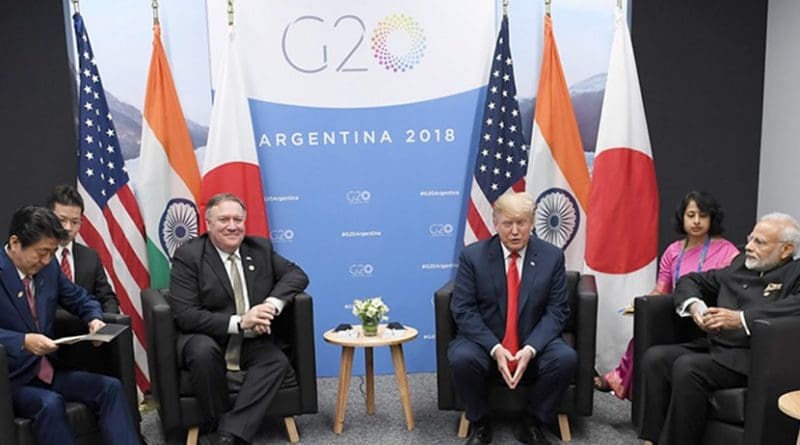Are Big Powers Pivoting Towards India? – Analysis
By RSIS
China, Russia, Japan and the United States sought to pivot towards India on the margins of the recently-concluded G20 summit. For Delhi, which wants to become a leading power rather than a balancer, the choice of right partners is challenging.
By P S Suryanarayana*
Surprising as it may seem, India was a key interlocutor for both China and the United States, trade adversaries, on the margins of the 13th summit of Group of Twenty (G20) in Buenos Aires on 30 November and 1 December 2018. This was a manifestation of big-power geopolitics.
Besides these two countries, Russia, China’s “coordinating” partner, and Japan, America’s foremost strategic partner in Asia, interacted closely with India on that occasion. Such a flurry of diplomacy was a pointer to the possibility of India being viewed by major powers as a potential swing-state or balancer in the current nebulous global order.
A Flurry of Summits: Indo-Pacific ‘Nucleus’?
The meetings, indicative of multidimensional pivoting towards India in this scenario, took place in the following order. Chinese President Xi Jinping and Indian Prime Minister Narendra Modi held talks on 30 November 2018, marking their fourth bilateral summit in just seven months.
Xi then joined Russian President Vladimir Putin and Modi for the first Russia-India-China (RIC) trilateral summit since 2006. Subsequently, Japanese Prime Minister Shinzo Abe met Modi and US President Donald Trump on the G20 margins, also on the same day.
Trump discussed “trade” and “defence” with Modi and Abe. Their talks on issues concerning Indo-Pacific, held at Abe’s initiative, marked the first-ever summit among these three ‘Malabar’ partners.
‘Malabar’ is the high-quality naval exercise that features the US, India and Japan every year. Washington and Tokyo are long-standing military partners, while Delhi is moving towards all-round defence cooperation with America.
Overarching the Delhi-Washington defence links, the latest Japan-America-India forum seems to constitute an embryonic Indo-Pacific ‘nucleus’ or core group. Modi enthusiastically coined the acronym of ‘JAI’ (Japan-America-India) for this forum to synchronise with the Hindi word for “success”.
This meeting may have, arguably, messaged the primacy of these three countries, rather than the Quad (which includes Australia), in the evolving Indo-Pacific dynamics. More significantly, the US and Japan, old partners, have now clearly pivoted towards India in the Indo-Pacific.
Eurasia ‘Caucus’?
On the G20 sidelines, Putin piloted the latest RIC summit to promote “cooperation” and “closer coordination” among Russia, India and China in “Eurasia”. These countries have been meeting at sub-summit levels since the RIC summit in St Petersburg in 2006. However, the current revival of the RIC summit signals urgency to create a Eurasia ‘Caucus’.
The RIC, if led by the highest leaders of its constituent states into the future, can be a formidable rival to an Indo-Pacific core group spearheaded by the US and Japan. This calculation obviously guided Putin.
Beijing and Moscow have in recent years acted in concert on the international stage. Recognising India as a major power since 2015, China has in recent months intensified its engagement with India. These realities should account for Putin’s current success in re-elevating the RIC to that of a leaders-led forum. But a more powerful China might want to lead the RIC if the emerging Indo-Pacific ‘nucleus’ stabilises.
Four ‘Pivots’
In conventional wisdom, India’s presence in both these groups can be a complicating factor for the other players. Moreover, Delhi, on its part, has already clarified that it aspires to be “a leading power” rather than a balancing actor in geopolitics and geo-economics.
Nonetheless, Japan, America, China and Russia are pivoting towards India, practically treating Delhi as a balancer or a swing-state which, by tilting to one side or the other, can strengthen the favoured outfit.
Eager to maintain China’s ties with America on an even keel, Xi appears equally keen to prevent India from allying with Washington against Chinese interests. Xi’s two-day-long informal summit with Modi at Wuhan (China) in April 2018 signalled the start of China’s experiment of pivoting towards India.
Japan’s focus on India is triggered by their shared interest in ensuring that a powerful China becomes less ‘threatening’. Abe has recognised India’s potential as a strategic asset in his vision of a “confluence” of the Indian and Pacific oceans.
For Washington, Delhi is a potential partner in keeping Beijing’s rise within manageable limits. Trump recently startled the world, especially China and Russia, by outlining his Indo-Pacific vision which pivots towards India. Now, by joining hands with Modi and Abe, Trump has hinted that the Indo-Pacific stays on his strategic radar.
Moreover, Russia traces its relationship with India to the old Soviet-era and tends to see Delhi as a valuable partner in dealing with Beijing. Putin’s friendly outreach towards Delhi is evident on two counts: the way he championed India’s recent admission to the China-dominated Shanghai Cooperation Organisation, and his latest revival of the RIC summit. All these considerations account for the four pivots towards India.
Pleasant Dilemma?
This happy situation of being ‘pivotal’ to the interests of big powers can turn tricky for India if it has to eventually choose its place.
Russia has remained India’s long-standing strategic partner despite occasional uncertainties, while Delhi cannot overlook China’s importance as a big neighbour. Some would, therefore, suggest that India take care of its ‘national interest’ and stay in the RIC, if Russia and China can keep the group going.
It is also not yet clear whether the Indo-Pacific will be more of a values-based rather than a national interest-driven outfit. The values being articulated are democracy, free and open oceans, ASEAN centrality etc. For India, choices will become manageable only if it enhances its comprehensive national strength and becomes “a leading power”.
*P S Suryanarayana is a Visiting Senior Fellow with the South Asia Programme, S. Rajaratnam School of International Studies (RSIS), Nanyang Technological University (NTU), Singapore. He is the author of ‘Smart Diplomacy: Exploring China-India Synergy’ (2016).

